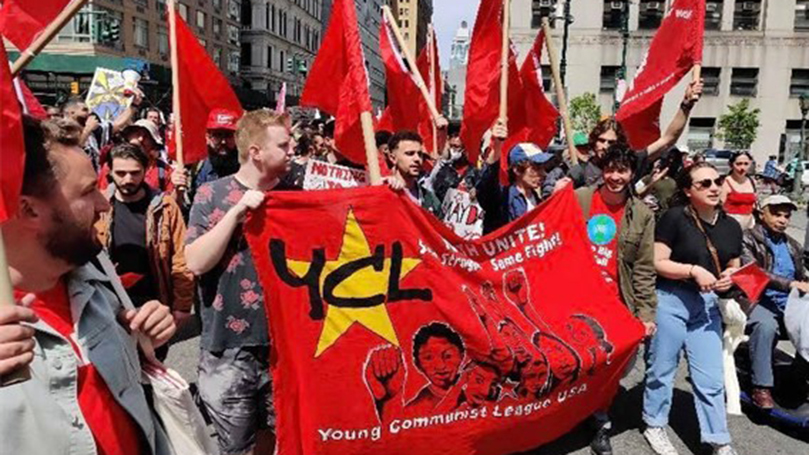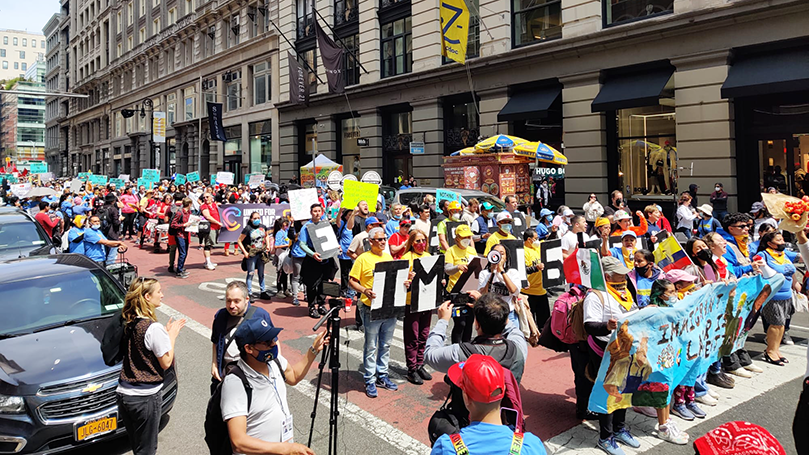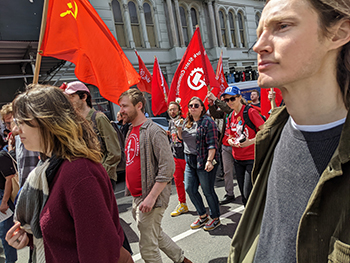
On International Workers Day members of the Communist Party and Young Communist League in New York City came out to support workers in the continued struggle against capitalist exploitation. This May Day action, which was the largest in a decade, proved that workers understand that it is our class that generates and holds power. Members of CPUSA and YCL marched collectively, carrying red flags and signs in solidarity with the labor struggle. We celebrated the resilience of this militant worker movement and continue to note that Communists have always been essential in fighting for the whole of the working class.
CPUSA also demonstrated its continued support for all worker struggles as we followed our Amazon Labor Union comrades in the parade. As the ALU fights for recognition of their union, the party acknowledged their organizing power with chants such as “Up with the workers, down with the bosses!” and “What’s disgusting, union busting!” We sang “Solidarity Forever,” the Ralph Chaplin song written for Lucy Parsons for a January 15, 1915, march in Chicago. The party’s chants, flags, and signs all showed that it is the workers’ labor that accumulates super profits for capitalists and it is the workers that will win against economic subjugation.
Just as it took a popular front of groups to help the Amazon Labor Union win their decisive victory, this year’s May Day represents the coalitional unity of working-class groups in fighting toward working-class power. Organizations present include Teamsters Local 79, ALU, New Immigrant Community Empowerment (NICE), RWDSU, the Communist Party, Make the Road New York, Churches United for Fair Housing (CUFFH), Building Trades for Worker Democracy, Industrial Workers of the World (IWW), Arab American Association of New York, and many more.
The radical history of May Day
From the beginning of the labor movement in the United States, May Day has been essential for building working-class solidarity and fighting for worker rights. Starting in the early 19th century, the working class demanded that their essential labor be valued. Before the 19th century when workers demanded shorter, eight-hour days, it was customary to work 18–20-hour work shifts, especially in the agricultural and textile sectors.

From the beginning of the U.S. labor movement, it was Left radicalism that offered an avenue to break the cycle of capitalist exploitation. From the Pennsylvania coal miner strikes of 1875 to the great steel and railroad strikes of 1877, these early labor struggles inspired worker militancy toward winning the eight-hour workday. Leading up to the historic 1886 May Day action, the number of strikes and walkouts grew all over the country. This not only represented the desire of workers for concrete economic demands, but an understanding of workers to fight against the capitalist system.
In a history of May Day, Alexander Trachtenberg writes:
The number of strikes during 1885 and 1886 as compared with previous years shows what a spirit of militancy was animating the labor movement. Not only were the workers preparing for action on May First, 1886, but in 1885 the number of strikes already showed an appreciable increase. During the years 1881-1884 the number of strikes and lockouts averaged less than 500, and on the average involved only about 150,000 workers a year. The strikes and lockouts in 1885 increased to about 700 and the number of workers involved jumped to 250,000. In 1886 the number of strikes more than doubled over 1885, attaining to as many as 1,572, with a proportional increase in the number of workers affected, now 600,000.
This aligned with an increase in establishments affected by strikes generally, from 2,467 to 11,562. This constituted over 500,000 workers fighting for a decrease in the working day to eight hours and building a response to the destructive effects of capitalism. On May 1, 1886, the first of these major demonstrations was held, with 350,000 workers throughout the country demanding the eight-hour workday. In Chicago 40,000 workers demonstrated, and in New York City 10,000 turned out.
The capitalist state responded to these workers by using its police force to attack the movement. This resulted in events such as the Haymarket Affair in Chicago, where radical organizers were detained and seven murdered by the state. But this did not stop the workers from struggling against the forces of capitalism.
May Day has always demonstrated the power and unity of the working class. As Friedrich Engels said on May Day in 1890, the unity of the working class will be a central component in the consolidation of power for the Proletariat:
As I write these lines, the proletariat of Europe and America is holding a review of its forces; it is mobilized for the first time as One army, under One Bag, and fighting One immediate aim: an eight-hour working day, established by legal enactment. . . . The spectacle we are now witnessing will make the capitalists and landowners of all lands realize that today the proletarians of all lands are, in very truth, united.
The legacy of May Day inspires us and assists in sparking class consciousness among the whole working class. It is the power of the working class that not only fights for a shorter workday but for the transformation of the economic system toward Socialism. As the German revolutionary Rosa Luxemburg emphasized, <indentThe first of May demanded the introduction of the eight-hour day. But even after this goal was reached, May Day was not given up. As long as the struggle of the workers against the bourgeoisie and the ruling class continues, as long as all demands are not met, May Day will be the yearly expression of these demands.
Solidarity with all workers!
May Day represents not only the fight of workers within specific industries but also the importance of combating racism and all forms of worker subjugation. It’s essential to stand with our brothers and sisters, especially immigrant workers, in the struggle against capitalist exploitation. Their labor is especially exploited for super profits: from the agricultural sector to Amazon, Black and brown immigrant workers face the brunt of a system that values profit over worker rights.
 We will continue to fight alongside the most oppressed workers who face exploitation from the capitalist system. Being in solidarity with these workers results in freedom for all workers, As Marx aptly emphasized, “In the United States of America, any sort of independent labor movement was paralyzed so long as slavery disfigured a part of the republic. Labor with a white skin cannot emancipate itself where labor with a black skin is branded.” The liberation of all workers requires that we fight all forms of worker oppression, including the racism and threats of deportation experienced by immigrants and the poverty wages they receive.
We will continue to fight alongside the most oppressed workers who face exploitation from the capitalist system. Being in solidarity with these workers results in freedom for all workers, As Marx aptly emphasized, “In the United States of America, any sort of independent labor movement was paralyzed so long as slavery disfigured a part of the republic. Labor with a white skin cannot emancipate itself where labor with a black skin is branded.” The liberation of all workers requires that we fight all forms of worker oppression, including the racism and threats of deportation experienced by immigrants and the poverty wages they receive.
As a representative from the Arab American Association of New York pointed out at the rally, these workers are not only the most vulnerable under capitalism, but it is their labor that makes production possible to begin with:
We are now three years into the pandemic and we still witness the devaluing of workers, especially immigrant workers. This country was founded on the labor of immigrant workers; from farm workers to factory workers, this country was founded on exploitation. This country survives on the labor of immigrants in every industry. We are here in the streets to demand more for immigrant workers, we demand health care, shelter, and pathway to citizenship. We want more for the workers that this country exploits every single day and uses for cheap labor.
While fighting for better working conditions for immigrant workers, we should simultaneously celebrate their achievements. . One worker, Jason Anthony, a lead organizer in the Amazon Labor Union, alluded to this point, stating, <indentWe should not only recognize the struggles of the worker movement but also . . . their achievements. We should be acknowledging and receiving immigrants that come from all over. New York City is a melting pot, that is why it is so diverse and that is why there’s so many types of workers. . . . [Workers] move everything, not the billionaires, not the one percent, but the 99 percent moves the economy.
The legacy of Communists in the labor movement
Historically, the Communist Party has played a leading role in the labor movement. This is because Communist goals will always align with the interests of the workers. These goals will always represent the progressive and radical needs of all working-class people. The Communist Party USA continues to struggle for less exploitative working conditions, while fighting to transform the system of production that oppresses us.
Justine Medina, an organizer with the Amazon Labor Union and Co-chair of the Young Communist League, emphasized that throughout the struggle of the ALU it was individuals from varying fronts, including the CPUSA and YCL, that made it possible for the ALU to win. We were a part of this popular front of organizations who phone-banked for the ALU and contributed to their historic win. As Medina said, the Party continues to be an essential part of the worker struggle toward liberation:
The Communist Party has been an integral part of the labor movement from the very beginning. The Communist Party for the last 100 years has been intimately tied within the labor movement and we saw that with ALU too. ALU was a popular front, it had people from all ideologies, backgrounds, nationalities, races, all represented. That includes the Communist Party, we were there, we’re gonna be there, we’re going to be doing what we can to help support the workers and building up the labor movement of this country again and supporting the worker revolution.
The CPUSA will continue to fight alongside workers, supporting the struggle toward liberation until the battle against capitalism is won. The collective efforts of the Communist Party, the ALU, and all radical groups has shown that working-class movements will remain a threat to the order of the capitalist class. As C. E. Ruthenberg wrote in 1923: “May Day — the day which inspires fear in the hearts of the capitalists and hope in the workers — the workers the world over — will find the Communist movement this year stronger in the U.S. than at any time in its history. . . . The road is clear for greater achievements, and in the United States as elsewhere in the world the future belongs to Communism.”
In a Weekly Worker of a generation before, Eugene V. Debs wrote in a May Day edition of the paper, published on April 27, 1907: “This is the first and only International Labor Day. It belongs to the working class and is dedicated to the Revolution.”
Images: New York CPUSA.


 Join Now
Join Now